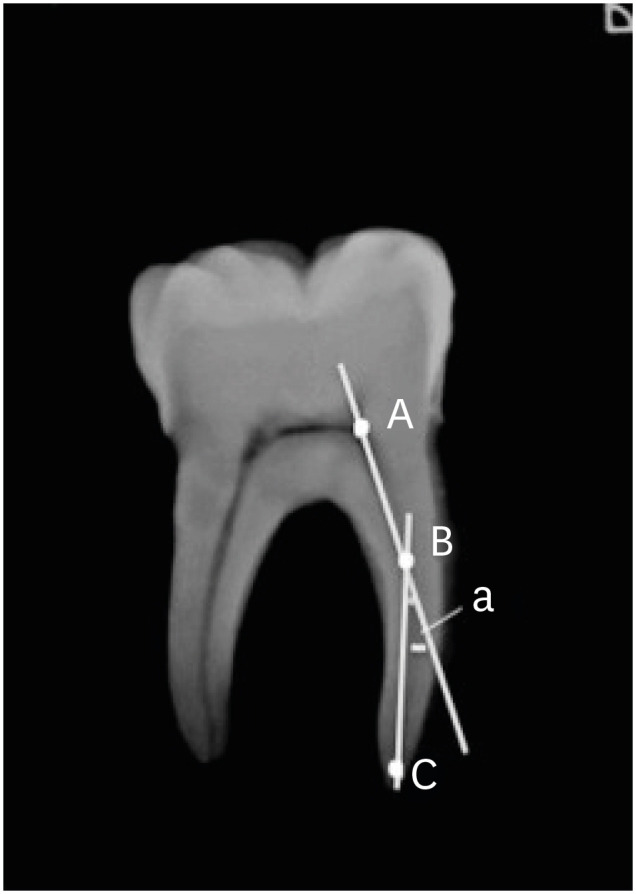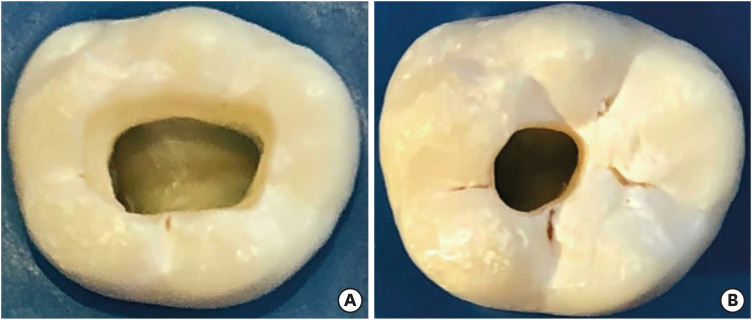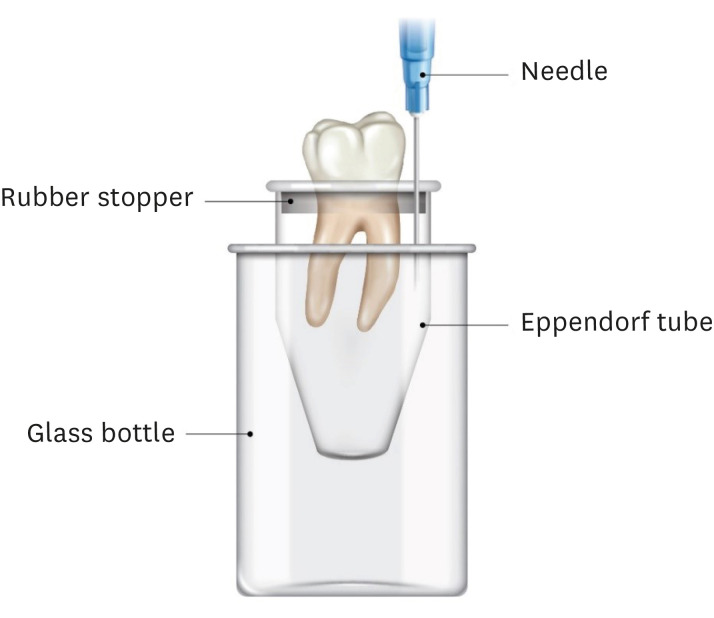1. Seltzer S, Naidorf IJ. Flare-ups in endodontics: I. Etiological factors. J Endod. 1985; 11:472–478. PMID:
3868692.

2. Siqueira JF Jr, Rôças IN, Favieri A, Machado AG, Gahyva SM, Oliveira JC, Abad EC. Incidence of postoperative pain after intracanal procedures based on an antimicrobial strategy. J Endod. 2002; 28:457–460. PMID:
12067129.
3. Tinaz AC, Alacam T, Uzun O, Maden M, Kayaoglu G. The effect of disruption of apical constriction on periapical extrusion. J Endod. 2005; 31:533–535. PMID:
15980716.
4. Tanalp J, Kaptan F, Sert S, Kayahan B, Bayirl G. Quantitative evaluation of the amount of apically extruded debris using 3 different rotary instrumentation systems. Oral Surg Oral Med Oral Pathol Oral Radiol Endod. 2006; 101:250–257. PMID:
16448929.

5. Patel S, Rhodes J. A practical guide to endodontic access cavity preparation in molar teeth. Br Dent J. 2007; 203:133–140. PMID:
17694021.

6. Christie WH, Thompson GK. The importance of endodontic access in locating maxillary and mandibular molar canals. J Can Dent Assoc. 1994; 60:527–532. PMID:
8032994.
7. Clark D, Khademi J. Modern endodontic access and dentin conservation, part 1. Dent Today. 2009; 28:86–90.
8. Clark D, Khademi J. Modern molar endodontic access and directed dentin conservation. Dent Clin North Am. 2010; 54:249–273. PMID:
20433977.

9. Clark D, Khademi JA. Case studies in modern molar endodontic access and directed dentin conservation. Dent Clin North Am. 2010; 54:275–289. PMID:
20433978.

10. Zelic K, Vukicevic A, Jovicic G, Aleksandrovic S, Filipovic N, Djuric M. Mechanical weakening of devitalized teeth: three-dimensional Finite Element Analysis and prediction of tooth fracture. Int Endod J. 2015; 48:850–863. PMID:
25243348.

11. De-Deus G, Silva EJ, Vieira VT, Belladonna FG, Elias CN, Plotino G, Grande NM. Blue thermomechanical treatment optimizes fatigue resistance and flexibility of the Reciproc files. J Endod. 2017; 43:462–466. PMID:
28131415.

12. Gündoğar M, Özyürek T. Cyclic fatigue resistance of OneShape, HyFlex EDM, WaveOne Gold, and Reciproc Blue nickel-titanium instruments. J Endod. 2017; 43:1192–1196. PMID:
28527845.

13. Koçak S, Koçak MM, Sağlam BC, Türker SA, Sağsen B, Er Ö. Apical extrusion of debris using self-adjusting file, reciprocating single-file, and 2 rotary instrumentation systems. J Endod. 2013; 39:1278–1280. PMID:
24041391.

14. Lu Y, Wang R, Zhang L, Li HL, Zheng QH, Zhou XD, Huang DM. Apically extruded debris and irrigant with two Ni-Ti systems and hand files when removing root fillings: a laboratory study. Int Endod J. 2013; 46:1125–1130. PMID:
23566178.

15. Schneider SW. A comparison of canal preparations in straight and curved root canals. Oral Surg Oral Med Oral Pathol. 1971; 32:271–275. PMID:
5284110.

16. Schäfer E, Diez C, Hoppe W, Tepel J. Roentgenographic investigation of frequency and degree of canal curvatures in human permanent teeth. J Endod. 2002; 28:211–216. PMID:
12017184.
17. Ingle JI. Endodontic cavity preparation. In : Ingle J, Tamber J, editors. Endodontics. 3rd ed. Philadelphia, PA: Lea & Febiger;1985. p. 102–167.
18. Krishan R, Paqué F, Ossareh A, Kishen A, Dao T, Friedman S. Impacts of conservative endodontic cavity on root canal instrumentation efficacy and resistance to fracture assessed in incisors, premolars, and molars. J Endod. 2014; 40:1160–1166. PMID:
25069925.

19. Bürklein S, Benten S, Schäfer E. Quantitative evaluation of apically extruded debris with different single-file systems: Reciproc, F360 and OneShape versus Mtwo. Int Endod J. 2014; 47:405–409. PMID:
23889673.

20. Ruiz-Hubard EE, Gutmann JL, Wagner MJ. A quantitative assessment of canal debris forced periapically during root canal instrumentation using two different techniques. J Endod. 1987; 13:554–558. PMID:
3482231.

21. Tanalp J, Güngör T. Apical extrusion of debris: a literature review of an inherent occurrence during root canal treatment. Int Endod J. 2014; 47:211–221. PMID:
23711187.

22. Üstün Y, Çanakçi BC, Dinçer AN, Er O, Düzgün S. Evaluation of apically extruded debris associated with several Ni-Ti systems. Int Endod J. 2015; 48:701–704. PMID:
25112960.

23. Bóveda C, Kishen A. Contracted endodontic cavities: the foundation for less invasive alternatives in the management of apical periodontitis. Endod Topics. 2015; 33:169–186.

24. Wilcox LR, Walton RE, Case WB. Molar access: shape and outline according to orifice locations. J Endod. 1989; 15:315–318. PMID:
2638391.

25. Rover G, Belladonna FG, Bortoluzzi EA, De-Deus G, Silva EJNL, Teixeira CS. Influence of access cavity design on root canal detection, instrumentation efficacy, and fracture resistance assessed in maxillary molars. J Endod. 2017; 43:1657–1662. PMID:
28739013.

26. Topçuoğlu HS, Üstün Y, Akpek F, Aktı A, Topçuoğlu G. Effect of coronal flaring on apical extrusion of debris during root canal instrumentation using single-file systems. Int Endod J. 2016; 49:884–889. PMID:
26283644.

27. De-Deus G, Neves A, Silva EJ, Mendonça TA, Lourenço C, Calixto C, Lima EJ. Apically extruded dentin debris by reciprocating single-file and multi-file rotary system. Clin Oral Investig. 2015; 19:357–361.

28. Marchesan MA, Lloyd A, Clement DJ, McFarland JD, Friedman S. Impacts of contracted endodontic cavities on primary root canal curvature parameters in mandibular molars. J Endod. 2018; 44:1558–1562. PMID:
30154004.

29. Zhao D, Shen Y, Peng B, Haapasalo M. Root canal preparation of mandibular molars with 3 nickel-titanium rotary instruments: a micro-computed tomographic study. J Endod. 2014; 40:1860–1864. PMID:
25205262.
30. Huang X, Ling J, Wei X, Gu L. Quantitative evaluation of debris extruded apically by using ProTaper Universal Tulsa rotary system in endodontic retreatment. J Endod. 2007; 33:1102–1105. PMID:
17931943.

31. Hülsmann M, Hahn W. Complications during root canal irrigation--literature review and case reports. Int Endod J. 2000; 33:186–193. PMID:
11307434.





 PDF
PDF Citation
Citation Print
Print






 XML Download
XML Download